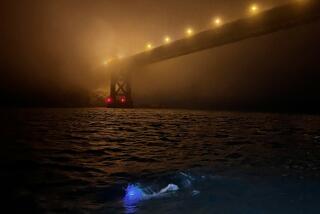Hitting a New Low
Tanya Streeter recently returned to the Turks and Caicos Islands, a small chain of Caribbean islands known for pristine waters and dramatic sea walls, which in places drop abruptly to depths of more than 7,500 feet.
It was in these waters last August that Streeter dived 525 feet, deeper than anyone had previously plunged without the benefit of scuba gear.
She has come back to this exotic, tranquil setting in pursuit of another world record in the death-defying sport of free diving.
After taking a deep breath, she will descend on a weighted sled into the murky depths before kicking and pulling her way up a guide rope to the surface in an attempt to break the womenâs record of 312 feet in variable ballast diving. She will need to hold her breath for more than three minutes.
Streeter says the satisfaction she derives from such dives is twofold.
âItâs the peace of being quiet and alone -- only hearing your own heartbeat -- but also a very strong sense of inner peace, because I know Iâm challenging myself,â she said. âIt gives me a lot of strength.â
If her dive, scheduled for July 21, is successful, Streeter will become the first free diver to hold world records in all four disciplines of the sport.
But the worldâs most recognizable female free diver says the records are a small part of why she tests the limits of human physiology while wearing only a wetsuit, nose clip and flippers.
âThe world record is completely unimportant,â said Streeter, who is supported by several sponsors. âItâs a necessary evil to enable me to work with my husband, travel the world and raise awareness for environmental aquatic issues.â
Her agenda expanded after French free diver Audrey Mestre, 28, died in October attempting to break Streeterâs âno limitsâ world record of 525 feet during a dive off the Dominican Republic.
âAfter Audreyâs death, I was motivated to prove that [free diving] can be done safely,â Streeter said. âHer death was incredibly damaging for the sport and a tremendous loss.â
Mestre had descended on a weighted sled to 561 feet, but the inflatable lift bag used in no limits diving to jettison her to the surface failed. She lost consciousness and drifted away from the guide cable.
By the time her safety team brought her to the surface, Mestre had been underwater for more than eight minutes and was brain dead.
When Streeter set her no limits world record, she completed her dive in less than three minutes.
Mestreâs death raised questions about the precautions taken by her safety team. Much of the criticism has been directed at Mestreâs husband, Cuban free diver Pipin Ferreras, who this month will attempt a no limits dive of 558 feet, the depth his wife reached during one of her training dives last October.
â[Mestre] was managed and controlled by a team of people that I think were not paying enough attention to safety,â Streeter said. âThe reason she died is because there was no safety system in place that was adequate.â
Streeter, 30, knows that safety is paramount in free diving, which causes tremendous physical change. Water pressure becomes so great that a diverâs lung volume halves every 33 feet, and air canals and sinuses become compressed.
At 300 feet, the body starts to shrink from the pressure. Streeterâs chest will lose about seven inches in diameter and her lungs will be reduced to the size of small fists and start filling with blood. Her eardrums will ache intensely and she may suffer from narcosis as the nitrogen builds in her blood, causing her to feel disoriented.
And thatâs not even the most dangerous part.
A diverâs greatest threat is shallow-water blackout, which can occur during the rapid ascent through the last two atmospheres of pressure, where oxygen can be sucked out of a diverâs blood as the lungs re-expand.
âYou want to avoid [blackouts], but you do have to push yourself and recognize your abilities and maximize your performance,â said Streeter, who admitted to blacking out on a handful of dives.
To prepare for such physical demands, the 5-foot-7, 120-pound Streeter trained up to three hours a day starting in April. Her regimen included holding her breath underwater in a pool.
Streeter was born in the Cayman Islands and spent so much time in the water as a child that she believed she could breathe underwater. She was educated in England and now lives in Austin, Texas, with her English-born husband and manager, Paul.
In the weeks leading up to her world-record attempt, Streeter planned 14 training dives to become acclimated to the depth and pressure. Scuba divers will be stationed every 60 feet and two free divers will be at the surface, ready to swim down and pull her to safety in case of accident. Because free divers do not breathe compressed oxygen, they are not at risk of the bends.
Although she didnât discover free diving until six years ago, when she joined her husband and friends on a spear-fishing trip, Streeter quickly took to the sport and set the first of seven world records in January 1998. She was inducted into the Women Diverâs Hall of Fame in 2000.
âThe average person doesnât understand that weâre all physiologically equipped to do this,â she said. âThereâs nothing different about me. I donât have webbed feet or gills. I donât even have big lungs. Itâs a mental game.
âBut most people just canât get around the idea of holding your breath six, seven and even eight minutes, and it being completely safe.â
Of course, as Streeter can attest, sometimes her dives are not as hitch-free as they appear.
When she became the first woman to break a menâs world record in no limits diving last year (Frenchman Loic Leferme has since regained the record), Streeter cost herself several valuable seconds because of an error in judgment.
Fulfilling a goal she had set, Streeter blew a kiss to the ocean and took a few seconds to look around after reaching her goal of 525 feet.
Those simple acts took her out of her practiced routine and, coupled with the disorienting effects of narcosis, caused her to fumble with her inflatable lift bag until realizing that she hadnât pulled the release clip.
âIt didnât scare me, but on the way up it made me think, âOK, I donât want to do that again,â â she said.
So, was that nearly the kiss of death?
âThatâs completely overstating it,â she said. âNot even close.â
Pete Thomas is on assignment.
More to Read
Sign up for Essential California
The most important California stories and recommendations in your inbox every morning.
You may occasionally receive promotional content from the Los Angeles Times.










